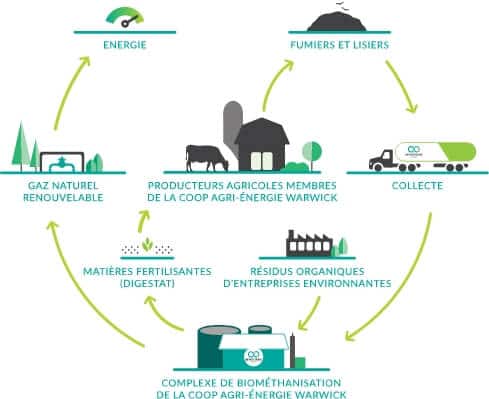
Coop Agri-Énergie Warwick is the very first agricultural cooperative dedicated to the production of Renewable Energy in Quebec. Biomethane, or renewable natural gas, is produced from manure, slurry and residual organic matter of surrounding businesses.
The Warwick biomethanisation complex was designed to blend into the rural environment in which it operates. It is located on a secondary road, more than 500 meters from any property, near Energir’s gas network.

After a few months of running-in, the Warwick biomethanisation complex is now injecting biomethane into the nearby Energir’s gas network. It thus contributes to the achievement of the government’s targets for the substitution of natural gas from fossil energy sources.
From the conception of the project through the daily operations of the complex, Coop Carbone handles all aspects of the development, commissioning and production of renewable natural gas for the agricultural cooperative.
The agricultural cooperative board of directors is formed by producers while Coop Carbone manages the complex, thus allowing agricultural producers to concentrate on their on-farm operations. Energir’s
Created in April 2019, the Coop Agri-Énergie Warwick is an agricultural cooperative with approximately ten agricultural members. In partnership with Coop Carbone, the Coop Agri-Énergie Warwick is developing the first cooperative agricultural biomethanisation project in Quebec in the Warwick region, in Central Quebec.
In early 2015, Coop Carbone launched the Agro-Carbone approach, which aims to reduce GHGs in the agri-food sector through structuring and collaborative projects. It is within this framework that the Coop Agri-Énergie Warwick was conceived.
Manures and other residual materials are brought to the Warwick biomethanisation complex to extract methane which will be purified into renewable natural gas.
The digestate, a co-product of biomethanisation, will be returned to the farms for spreading, thus completing the circular economy loop with, in addition, biomethane to replace fossil-based natural gas.

Yes, because of the other organic residual materials that are integrated into the manures and slurries (recipe).
Currently, only farmers and some input suppliers can be members. The majority of positions must be reserved for farmers.
No. Only farmer members supply the complex with agricultural residues.
Biomethane production allows farmers to diversify and increase their sources of income, participate in the energy transition, reduce odors from land spreading and obtain a digestate with a high agronomic value.
Mostly composed of carbon dioxide (CO2, about 40%) and methane (CH4, about 60%), biogas is a raw gas produced by the decomposition of putrescible organic matter.
Once purified, biogas becomes biomethane or renewable natural gas (RNG). Its properties allow it to be interchangeable with natural gas and therefore to be injected into a gas distribution network.
In Quebec, only residual organic materials are used in the production of biogas.
We work with agricultural businesses, regional county municipalities (RCM), etc.

The attendance of interested agricultural businesses (animal production or field crops)

Regional willingness to support cooperative agricultural biomethanisation as a lever for economic development and an energy transition tool.

The attendance of businesses that generate organic waste (agri-food, municipal or industrial sludge).

Site of interest near the gas network (green or white zone).

Commitment to cooperative values and willingness to invest (down payment).